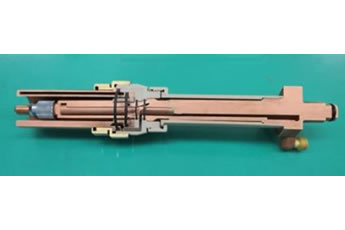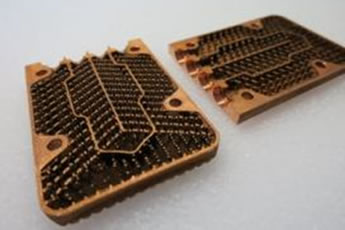Daihen establishes copper-alloy 3D additive manufacturing technology using a conventional metal 3D printer
Octber 26, 2016
[World's First]
Daihen establishes copper-alloy 3D additive manufacturing technology using a conventional metal 3D printer
- The copper alloy additive of excellent mechanical strength and electrical conductivity promises innovations in Monozukuri -
■Abstract
DAIHEN Corporation has established the world's first copper-alloy 3D additive manufacturing technology using a metal 3D printer, in joint development with the Technology Research Institute of Osaka Prefecture.
The practical realization of 3D additive manufacturing that makes the best use of the electrical conductivity and thermal conductivity of copper not only achieves support for high-mix, low-volume production and a drastic reduction in development time, but also enhances the potential for developing top-quality, high value-added formed products of complicated shapes that were considered impossible to produce with conventional processing methods. This opens the door to technological innovations for Monozukuri in all fields of industry, including the aerospace, automobile, and medical industries.
■Background to development
3D printers have rapidly spread to a wide variety of fields, including the hobby field as of recent, and become an item familiar with the public. Since copper is an essential material for Monozukuri because of its excellent electrical conductivity and thermal conductivity, the establishment of 3D additive manufacturing technology has been desired by industry. However, the copper additive manufacturing with a 3D printer has been considered difficult due to the high laser reflectance.
We at DAIHEN have independently established forming technology (i.e., know-how of copper alloy powder and processing process) that enables copper-alloy 3D additive manufacturing, using a general-purpose metal 3D printer ("M2" Printer with 400-watt laser output from Concept Laser GmbH), and acquired the patent for this technology.
< Advantages of 3D Additive Manufacturing >
- Possible to manufacture shapes of integral structure that are difficult to make by casting and cutting
The 3D additive manufacturing technology makes it possible to form structures that cannot be realized by conventional processing methods such as internal precision processing of hollow structural materials. Since this technology can be used to manufacture high-performance parts of new structure, new products are expected. - Drastic reduction in product development period
Forming from 3D digital data no longer requires dies, thus achieving a drastic reduction in lead-time in manufacturing processes such as prototyping. - Enhanced flexibility in production
This technology makes it possible to manufacture parts from digital data and metal powder, and reduce assembly labor, thus leading to flexible support for small-lot and custom-made parts. Furthermore, less need to store dies for maintenance parts and a reduction in parts inventory can be expected.
■Product development using the 3D additive manufacturing technology and future deployment
We have already utilized this technology to develop, a lot of prototype, and manufacture our own products. For example, we applied the technology to the high-current water-cooling torch used in the high-efficiency "D-Arc" welding system, to achieve high cooling performance and a compact, lightweight design.
The technology also makes it possible to change the characteristics of formed products according to their intended use. This means, when attaching importance to electrical conductivity, products with an electrical conductivity increased up to a maximum of 90% that of pure copper, and, when attaching importance to mechanical strength, products with a tensile strength increased up to a maximum of 3 times that of pure copper.
We are taking into consideration the future patent licensing of our 3D additive manufacturing technology in order to promote use far and wide. Furthermore, we are always ready to provide consultations with respect to forming prototypes.

Water-cooled torch used in the high-efficiency "D-Arc" welding system
High cooling efficiency and a compact, lightweight design unattainable by conventional methods have been achieved by constructing the optimum water-cooling circuit.
[Note: Cross-section showed for easy understanding of the construction]

Heat sink for motor cooling
Successful prototyping and verification of shapes that efficiently recover and dissipate heat generated by motors has contributed to an unprecedented expansion of applications into the high current region.
[Note: Cross-section showed for easy understanding of the construction]

